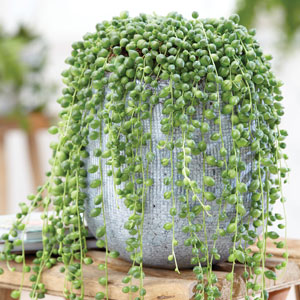String Of Pearls Growing Guide

What is String Of Pearls?
String of Pearls (Senecio rowleyanus) also known as String of Beads is a creeping, perennial succulent vine. It is part of the Asteraceae family and is native to Southwest Africa. String of Pearls gets it’s name from the green, pea shaped leaves that form along the weak slender stems. The leaf shape is a natural adaption in order to store water and minimise moisture loss in the arid environments of its natural home. During Autumn clusters of tiny, white, trumpet shaped flowers appear. These plants are usually kept in pots either inside or undercover such as a verandah or shade house as they like part to dapple shade. They can handle some direct sunlight, like morning sunlight, however too much can cause the leaves to burn. If keeping indoors String of Pearls requires a bright position. If the plant is looking unhealthy relocate it to a new spot.
Benefits of Growing String Of Pearls
String of Pearls are very easy to grow and require little attention. They are a unique looking plant. They are great for growing in hanging baskets or displayed on shelves, where their long stems can cascade over the edges. Outside, they look just as great in pots or hanging baskets, under trees or in rockeries.
How to Grow String Of Pearls
Climatic Zones
Cool, temperate, arid, semi arid.
Plant Size
They can trail up to 1m.
When To Plant String Of Pearls
Plant anytime.
Soil Preparation
They need a well drained, sandy soil. When planting in pots use a specialist succulent potting mix.
How To Plant String Of Pearls
Plant in part shade to dapple shade, plant at the depth the pot came in.
String Of Pearls Plant Care
Water when soil is dry to touch. Let dry out between waterings. Be careful with water as the stems can rot if they remain wet.
Feed with a slow release fertiliser in Autumn or Spring.
Cut off spent flowers and damaged or drying leaves.
Tip prune regularly to encourage an attractive multi- stemmed look. You can use these ‘cuttings’ to grow new plants. Note: The strings will not send out side shoots, they will continue to grow longer.
Re-pot in Spring once the plant becomes overcrowded.
Snails can be a problem. They can also attract aphids and mealybugs during the warmer months.







